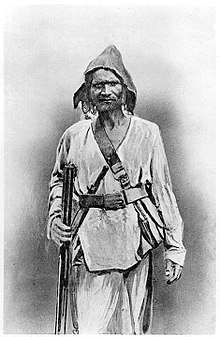Tantia Bhīl
Tantia Bhīl (or Tantya Bheel, Tantya Mama) (d. 1890) was a dacoit (bandit) active in British India between 1878 and 1889. He is described very negatively as a criminal in period British accounts, but is recognized by Indians as a heroic figure. Accounts of both eras have described him as an Indian "Robin Hood".
Mama Tantiya Bhil | |
|---|---|
तांट्य भील | |
 Illustration from The Tribes and Castes of the Central Provinces of India (1916) | |
| Born | 1840/1842 |
| Died | 1890 |
| Cause of death | Hanged |
| Resting place | Patalpani, Madhya Pradesh) |
| Known for | First War of Independence |
Career
Tantia was a member of the Bhil tribe, of the indigenous Adivasi community, and born in Nimad, Madhya Pradesh around 1844. Per one modern account he embarked on his career after the harsh measures taken by the British following the Indian Rebellion of 1857.[1] Tantia was first arrested around 1874 for "bad livelihood" and after a year's sentence turned to more serious crimes of theft and kidnapping. He was arrested in 1878 by Haji Nasrullah Khan Yousufzai and jailed in Khandwa, escaping after only three days, and from there took up his career as a dacoit.[2]
Tantia was lured to a parley by an officer of the Indore army who promised him a pardon, but was ambushed and taken to Jubbulpore where he was tried and hanged in December 1890.[2]
History
It is an indisputable fact that freedom fighters have all along been termed as rebels by the powers that be it the Mughal Empire of Aurangzeb or the British rule. Tantya Bhil was one of the greatest revolutionaries who waged an armed struggle against the British rule for twelve years and endeared himself to the masses by virtue of his indomitable courage and passion to uproot the foreign rule. Political parties and educated class launched forceful movement for ending the British Rule. But much before these movements, tribal communities and revolutionary like Tantya Bhil raised a banner of revolt against the British rule. Tantya Bhil became a symbol of the feelings of tribals and general people.
About one hundred twenty years ago Tantya Bhil emerged as a great hero of the masses and became since then a long cherished pride of Bhil tribe. He epitomized the indomitable courage, exceptional agility and organizing skill.
Tantya Bhil used to plunder the government treasuries of the British government and wealth of their sycophants used to distribute it among the poor and needy. In fact, he was the Messiah of the have-nots. He was popularly called Mama by people of all age groups. This address of Tantya became so popular that the Bhills still feel proud in being addressed as "Mama". He used to reach out to those who were in need of financial help in a miraculous manner.
The news of the arrest of Tantya Bhil was prominently published in the 10 November 1889 issue of the New York Times. In this news he was described as the "Robin Hood of India".[3]
Tantya Bhil was born at village Badada in Pandhana tahasil of East Nimar (Khandwa) of erstwhile Central Provinces which currently lies in the Indian state of Madhya Pradesh. He wanted to teach a lesson to the British and to realize Bhils’ dream of socialist society. He was fired with a passion to free India from British subjugation. He broke the jail many times.
He was skillful in Guerilla warfare. He was also a great shooter and proficient in traditional archery. "Dava" or Falia was his main weapon. He had also learnt to handle gun.
Right from his young age he lived in dense forests, valleys, ravines and mountains all his life measuring swords with the British and Holkar State's armies. He inflected reverses on the police of mighty British Empire and eluded them for many years. Thousands of people were arrested and hundreds of them were thrown behind bars on the charge of helping Tantya.
Ultimately, Tantya was arrested due to treachery of Ganpat, the husband of his formal sister. He was kept in the Central India Agency jail in the British Residency area at Indore. Later, he was taken to Jabalpur under strict police guard. He was heavily chained and kept in Jabalpur jail where the British officers tortured him inhumanly. All types of atrocities were perpetrated on him. The Sessions Court, Jabalpur sentenced him to be hanged till death on 19 October 1889.
The British government was so scared that even today it is not known as to when and on which date he was hanged. It is generally believed that after hanging him his body was thrown near Patalpani railway station on Khandwa rail route near Indore. The spot where his wooden effigies were placed is considered to be the Samadhi of Tantya Mama. Even today all the train drivers stop the train for a moment as a mark of respect to Tantya Mama.
Coverage in Raj media
An 1891 article on rhinoplasty in The Lancet presented a Maratha Brahmin patient whose nose was restored after having been cut off by Tantia Bhil shortly before his capture, and remarked Tantia's surprise, when confronted with the Brahmin whose nose had been restored before he entered the witness-box, was very amusing.[4]
Filmography
- Do Waqt Ki Roti (1988)
- Tantya Bheel (2012)
Further reading
- Sher-i-Nimar Tantiya Bhil. S. Tadwal, Adivasi Ekta Parishad, 2000
- The Bhil kills. S. C. Varma, Kunj Pub. House, 1978
References
- Ramaṇikā Guptā; Anup Beniwal (1 January 2007). Tribal Contemporary Issues: Appraisal and Intervention. Concept Publishing Company. pp. 18–. ISBN 978-81-8069-475-2.
- Central Provinces (India) (1908). Nimar. Printed at the Pioneer Press. pp. 45–.
- "Bob White: Who can challenge our Robin Hood for his title?". 8 September 2014.
- The Lancet. J. Onwhyn. 1891. pp. 422–.